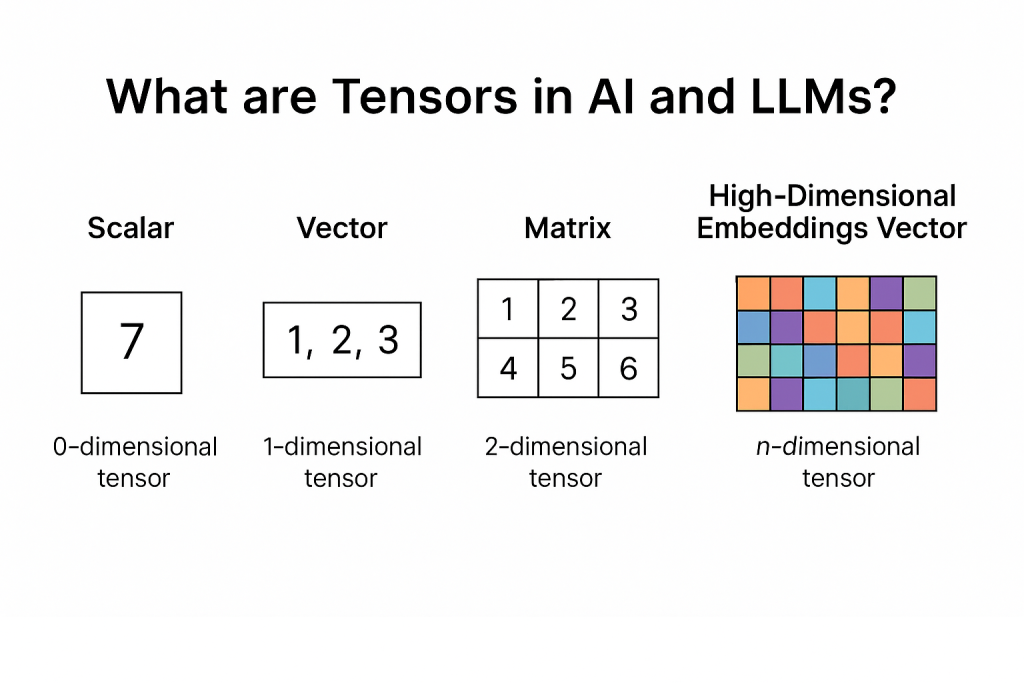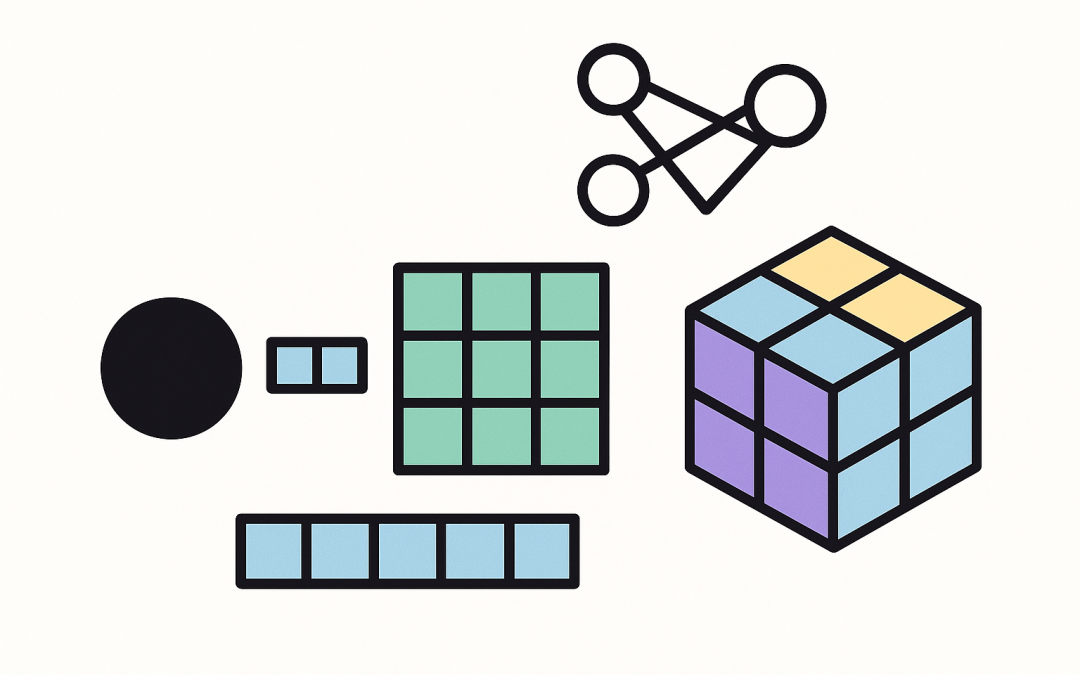In this post “What Are Tensors in AI and Large Language Models (LLMs)?”, we’ll explore what tensors are, how they are used in AI and LLMs, and why they matter for organizations looking to leverage machine learning effectively.
Artificial Intelligence (AI) and Large Language Models (LLMs) like GPT-4 or LLaMA rely on complex mathematics and data structures under the hood. One of the most fundamental of these structures is the tensor. While the term might sound abstract, understanding tensors can help both technical professionals and mid-management leaders grasp how modern AI works and why these systems are so powerful.
What Is a Tensor?
At its core, a tensor is a multi-dimensional array — think of it as a generalization of numbers, vectors, and matrices:
- A scalar (a single number like
7) is a 0-dimensional tensor. - A vector (like
[1, 2, 3]) is a 1-dimensional tensor. - A matrix (like a table with rows and columns) is a 2-dimensional tensor.
- Higher-order tensors extend this idea to 3D, 4D, or even n-dimensional data. For example, an image with height, width, and color channels (RGB) is a 3D tensor.
Tensors are the standard data format used in AI frameworks such as TensorFlow and PyTorch. They allow neural networks to process data efficiently using specialized hardware like GPUs and TPUs.

Why Are Tensors Important in AI?
AI models, including deep learning systems, work by performing mathematical operations on tensors. For example:
- Training neural networks: During training, input data (text, images, or audio) is represented as tensors. Weights and biases within the model are also tensors. The training process updates these tensors to minimize error.
- Matrix multiplications: The “workhorse” operation of AI is multiplying tensors (matrices and vectors) to calculate relationships between inputs and outputs. This is how models learn to recognize patterns.
- Scalability: Tensors can be parallelized easily, meaning thousands of tensor operations can run at once on GPUs. This scalability is why AI has exploded in capability over the past decade.
In short, without tensors, modern AI would not exist.
Tensors in Large Language Models (LLMs)
LLMs like GPT-4, Claude, or LLaMA are built on billions (sometimes trillions) of parameters — each parameter is essentially a number stored in a tensor. Here’s how tensors come into play in LLMs:
- Token Embeddings
Text is converted into tokens (numeric representations of words or subwords). Each token is mapped into a high-dimensional tensor called an embedding vector. This vector captures semantic meaning — for instance, “king” and “queen” have similar embeddings. - Attention Mechanisms
The transformer architecture, which powers LLMs, uses tensors in its attention layers. These layers calculate relationships between tokens by multiplying and normalizing tensors to determine which words matter most in context. - Model Parameters
Every weight in an LLM is stored in tensors. A model with 175 billion parameters, like GPT-3, is essentially a massive collection of tensors optimized to predict the next word in a sequence. - Inference (Prediction)
When you type a prompt, your words are turned into tensors, passed through layer after layer of tensor operations, and the output tensor determines the most likely next token.
In simple terms, LLMs are giant tensor manipulation machines.
Business and Technical Relevance
For mid-management, understanding tensors is less about coding and more about appreciating why they matter strategically:
- Performance and Cost: Training and running LLMs requires massive tensor operations on GPUs/TPUs. This directly impacts cloud costs and infrastructure planning.
- Scalability: Tensors enable distributed training across multiple GPUs or nodes. Companies deploying LLMs must plan for how tensor operations scale in production.
- Accuracy and Innovation: The size and quality of tensor operations (such as embeddings) determine how well an AI system performs tasks like summarization, translation, or customer support.
For technical teams, working with tensors means knowing how to optimize memory usage, leverage hardware acceleration, and design models that balance accuracy with performance.
Common Misconceptions About Tensors
- “Tensors are only for data scientists.”
In reality, they affect cost, performance, and scalability — making them relevant to decision-makers. - “Tensors are too abstract to matter.”
While the math is complex, the business impact (speed, accuracy, cost) is concrete and measurable. - “LLMs are just text generators.”
Under the hood, they are systems that transform and manipulate tensors billions of times per second.
Conclusion
Tensors may seem like a niche mathematical concept, but they are the foundation of AI and LLMs. From embeddings to attention mechanisms, tensors drive how machines understand and generate human-like language.
For organizations, appreciating the role of tensors isn’t about learning advanced calculus — it’s about recognizing the strategic implications of how data, compute resources, and AI models interact. As companies adopt AI at scale, the ability to understand and manage tensor-based operations will play a critical role in balancing innovation, performance, and cost.
Discover more from CPI Consulting -Specialist Azure Consultancy
Subscribe to get the latest posts sent to your email.

